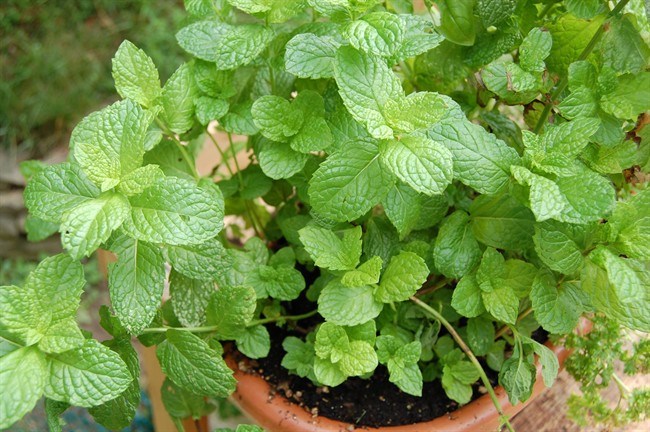LONDON, ONTARIO, - Award-winning cookbook author Naomi Duguid can't contain her enthusiasm when she talks about all the ways she likes to use fresh mint.
"I use it all the time. It's one of my faves, my standbys. I have spearmint. I make mint tea a lot with it, big handfuls of it in the teapot, and it's wonderful. You can drink it cold or hot, iced.
"I mince it finely and often combine it with shiso (a Japanese herb) and put it on a Thai grilled beef salad. I make potato salad or beet salad with just oil and vinegar ... and I put in a whole mix of herbs — tarragon and mint and chives.
"Mint has such a lovely refreshing taste."
Mint was already established in the garden when Duguid moved into her Toronto home.
"I just improvise with it," she continues. "It's such an obvious thing if you're making a cold soup and mince a little mint and chives up and put it as a little flourish on top of a vichyssoise or even a hot soup. I use it in a salad. It refreshes anything really."
One of the few things she doesn't like about mint is the sometimes hairy texture of the leaves. So unless they are very tender, she minces or chops them finely. "Then you get all the flavour without the coarse texture."
All of Duguid's suggestions use raw mint, although she says her mother used to put a big sprig of it in the pot when cooking peas or even potatoes.
"The difference between mint and some other herbs is that you don't use it much in cooked dishes. You use it raw. You use dried versions of thyme and oregano in cooking. It's quite different. Whereas with mint, you can chop it up and put a little vinegar and oil and turn it into a dressing for lamb. It's gorgeous."
Although spearmint and peppermint are the mainstays for culinary use, a large range of hybridized flavoured mints have also been developed — everything from grapefruit, ginger and chocolate to banana mint.
"Other people are fans and they love them, but I'm not," Duguid says. "I don't like them very much."
Dale Thacker of Bow Island, a small town between Medicine Hat and Lethbridge in southern Alberta, is one of the few mint farmers in Canada, and he and his brother and two neighbours account for "about a third of all the spearmint grown in North America."
Together they have about 1,400 hectares of mint, which they distil at their own plant into about 135,000 to 160,000 kilograms of pure spearmint oil per year, all of it destined for the toothpaste and chewing gum industries.
"They've tried to grow it in other regions of Canada, but it didn't do very well," Thacker says.
But the combination of the 975-metre altitude where the farms are located and the chinook winds that keep the fields relatively bare in winter are perfect for spearmint. Not so much for peppermint, which doesn't like northern latitudes. Thacker and company plowed up their peppermint last fall.
"Spearmint and peppermint look similar, but it's not the same plant at all. It has totally different growing characteristics, certainly different flavours." Varieties of mint with exotic flavours generally originate as the result of a cross between other plants and peppermint, he says.
It takes about three years of intensive and expensive work to establish a large crop of mint, Thacker says. "But once you get it started it's fairly robust."
"Aggressive" is a word used to describe mint by Mark Cullen, probably Canada's best-known gardener. Cullen, based in Unionville, Ont., says the best way to start mint for a home garden is to buy a nursery plant or dig up some roots from an established plant.
But he calls the perennial a "bully" that will try to take over the whole garden and suggests planting it inside the walls of a large coffee or juice can that has both ends removed and has been pushed half or two-thirds of the way into the earth. "That will hold it in place more or less." It will also do well in pots, where there is no danger of spreading.
"It tends to like an open, loamy soil, rather than clay, but once it's established, it has a reputation for growing in just about anything," he says.
"You can plant as soon as the frost is out of the ground. You can start to harvest it as soon as you have substantial top growth," in six to eight weeks, and it produces useable leaves most of the summer.
Mint likes a lot of water, he says. "But it's also tolerant of reasonable drought conditions. You can let it get quite dry come July and it's not going anywhere. It may stop growing ... but it'll bounce back. It rehydrates very nicely."
Because of the downy leaves, it's also not susceptible to common garden pests such as aphids or slugs.
Cullen is a big fan of mint but less for its culinary use (although he likes that too) than its ornamental value.
"It has a terrific bloom (in June) that attracts pollinators like honeybees and butterflies in a big way. And it's quite fragrant. If you have enough of it growing in your garden, you'll be aware of it with your eyes closed because it's pretty powerful.
"I grow 100 times more mint than my wife uses because I love those flowers."
———
To contact Susan Greer, email her at susan.greer(at)rogers.com.



